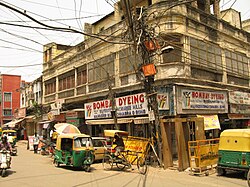Paharganj
[8][9] In the years after its establishment in 1638, Shahjahanabad, the capital of the Mughal Empire under Shah Jahan, was no longer contained within the walled city, it soon spilled into surrounding areas, stretching into miles at each end, where half of its population stayed.
[12] Between Paharganj and Akbarabadi gate of the walled city was Shahganj, another wholesale market, while on the other side towards Jantar Mantar was Raja Bazar.
[11] In fact, Paharganj was also referred as Shahganj or King's ganj or market place during Mughal era,[1] it gets its present name 'Paharganj', literally meaning Hilly neighbourhood, owing to its proximity to the Raisina Hill, where the Rashtrapati Bhavan stand today.
Though its neighboring area of Jaisinghpura,[1] where Gurudwara Bangla Sahib stands today, along with Madhoganj and Raja ka Bazaar were demolished to make way for the Connaught Place, shopping district.
This changed Paharganj landscape indelibly, with an influx of travelers, small eateries started coming up in the area, and also temporary residential facilities.
[20] The famous Shri Nand Lal Sharma dhaba was set up here in 1928, over time, his son built a three-storey hotel on spot, and now his grandson manages the Metropolis, known for its rooftop restaurant, which still has many Russian dishes on its menu.
[19] Gradually, the entire area was catering to the tourism industry, though the grain bazaars of Mughal era were long gone, in early 20th century, Paharganj still had principal markets in Delhi for building materials, cement, timber and steel, but by 1947 they had mostly shifted to other locations in the city, while Paharganj had become primarily a densely populated residential and commercial area, replete with cheap hotels and restaurants for domestic and foreign tourists.
In May 1924 on the day of Bakri Eid the Muslims of Pahari Dhiraj of Paharganj slaughtered the cow – which is revered by the Hindus as sacred Kamadhenu – in the slaughterhouse closer to the Jhandewala temple.
[31][32][33] In 2005, during 29 October 2005 Delhi serial bombings, the first blast took place in the main bazaar of Paharganj, during busy shopping period, two days before festival of Diwali.
[34][35] Paharganj is also home to the historic Qadam Sharif dargah, dedicated to the footprint of Muhammaf, originally built by Firuz Shah Tughlaq, a 14th-century Sultan of Delhi.
[38] The grave of poet laureate of Mughal court, Zauq, who lived nearby Nabi Karim and died in 1854, lies in the bylanes of Paharganj.
[43] In 2008, parts of the Hindi film, Dev.D (2009) directed by Anurag Kashyap were shot in Paharganj area, depicting the seedy side of hotel industry, from prostitution to drug peddling.








